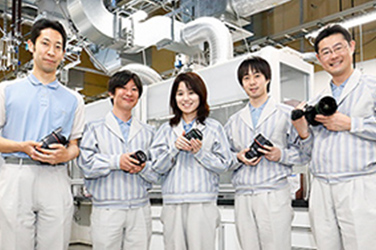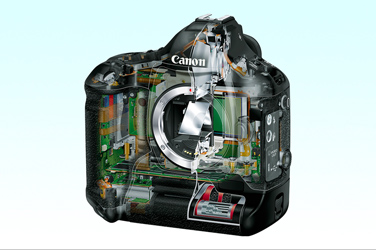Developers' Story
Opening up New Possibilities for Cameras
- Where it all started
- Verifying demand
- A flexible development philosophy
- Blending old and new technologies
- Intellectual property support
The PowerShot PICK is a camera that you would have been invented earlier?but didn’t exist until Canon filled the gap. It automatically shoots after determining the best composition, and excels in capturing photos of people with candid, natural expressions. Nobushige Wakamatsu, the man who first proposed the product idea, went on to helm its development as lead engineer. He tells us the story of how the PowerShot PICK came to be, from conceptualization to development and commercialization.
Where it all started
The desire to preserve the candid expressions of children
After my first child was born, we were so busy taking care of him, that we didn’t manage to photograph him as much as I wanted. As he became more aware of the world?and the camera, the photos that we did get would have him striking the same poses, or looking at the camera the same way. We didn’t get to record candid images of him behaving the way we, as parents, usually saw him: playing the clown, sulking, being shy. I thought that was a huge pity.
On top of that, I’m my family’s unofficial photographer. This also means that I don’t usually get to be in the photos unless I ask someone else to take them for me?kind of sad, isn’t it? So, I started wondering if there was a solution, and that’s where it started. I realized that there must be others who faced the same issues, and began thinking about a camera that could automatically find subjects, decide on what was a good photo opportunity, and take the photo.

Nobushige Wakamatsu
Wakamatsu is an engineer on the team that develops firmware for controlling hardware in the camera product development department, He currently balances that with developing updates and new services for the PowerShot PICK.
- The PowerShot PICK started as a personal idea. How did you manage to turn it into an actual project? Was it a smooth process?
When I first broached the idea to my superior, he felt that it would definitely have bearing on the cameras we were to develop in the future and encouraged me to go ahead with it! My colleagues were also for the idea?they thought it was an interesting project.
One question I get a lot is, “Did you believe from the very start that this idea of yours was possible to turn into reality?” I did. I had the conviction that such a camera was possible, as long as we brought together Canon’s technologies.
I develop camera firmware?that’s what I know best. But I also work closely with many other departments, such as those in charge of mechanical and electrical engineering. So, I had a pretty good idea of who I needed on the team: it was like, “Okay, I need to figure out a mechanism for moving the lens, let’s ask so-and-so from X department.”
We started as a small team of about 4 to 5 people consisting of colleagues that I had working relationships with.
Verifying demand
Votes of confidence from a CES exhibition and a Silicon Valley survey
As my idea was for a new concept camera that didn’t previously exist inside or outside Canon, I didn’t know if it aligned with the needs of global consumers. To take the camera to the development phase, I needed to prove that there was demand for it. So, I aimed to showcase it at the Consumer Electronic Show (CES), an influential consumer electronics trade show held every year in Las Vegas.
As the world’s largest exhibition of new products and prototypes, it also attracts people from all over the world who have a love for new gadgets. It was the perfect chance to observe an international audience’s response to the camera with our very own eyes.

CES?one of the world’s biggest consumer electronics trade shows.

Prototype in hand, Wakamatsu introduces the camera to event attendees.
CES was just a start. After that, we continued to exhibit prototypes and design mockups of the camera at various events held at key locations in Europe and Japan, in order to research user needs and explore the product’s business potential. Using Canon USA’s connections, we also conducted market surveys in Silicon Valley. Our findings that became a huge source of inspiration for the project team.
The engineer in charge of conducting the surveys at Silicon Valley did so by bringing a prototype into various cafes, where he gave presentations about it to complete strangers and sought their feedback. He did a number of rounds of that, and soon, we had accumulated a sizeable amount of user feedback, which proved that there was user demand for an automated camera.
When conducting surveys, in which our researcher met and interacted with many people, we also made some other discoveries. One was that there was still a significant number of people who didn’t mind not being in photographs, as long as their friends and family were in them. Another was that there was greater demand for video shooting capabilities than expected. And yet another was that the size of living rooms and backyards differed from country to country, and area to area.
A flexible development philosophy
A small team, just like a startup
We chose to develop the PowerShot PICK using “agile” processes, which required constant iterations of adaptation, testing, and improvement. We’d make the product, try it out, put it through tests, have team meetings where we went through the testing results together, update the specifications to improve it, and then repeat the process all over again.
We started out as a 4- to 5- member team, but after we proceeded into development, our team began to grow. With help from my seniors, I recruited team members who had expertise in fields that I was unfamiliar with, such as exterior design and activation sounds. It was amazing how all the talent that I needed for developing the product was already right there in the company. I believe it’s possible only somewhere like Canon, one of whose strengths is in developing and manufactures products in-house.

Starting the project and commercializing it also involved going through many administrative procedures, such as managing the development budget and coordinating with retail companies all over the world. The organizational support I received from experts in various fields allowed me to focus on developing the product as an engineer.
Blending old and new technologies
The background that turned an idea into reality
Canon has a huge wealth of technologies that it has pioneered over the years. These include foundational technologies used in imaging products, such as those related to optics, mechanical and electrical systems, and image processing. Thanks to that, I had the basic technologies needed to build a camera. Even at the ideation stage, there was always the sense that “If I use the technology that X department is developing, I will be able to do to Y.” The technical hurdles were never so high that I got discouraged from what I wanted to do.
For example, the PowerShot PICK moves its lenses horizontally and vertically to track subjects. However, we also needed the movement to be quiet so that children wouldn’t notice it, so that we could capture candid shots. I searched within Canon and found out that the Nano USM used in the latest camera lenses was the best technology for the job. So, we made it even smaller so that we could use it in the PowerShot PICK.

Intellectual property support
The vast variety of in-house patents that support product development by engineers
One of the most important jobs of a Canon engineer is to write patents. You can probably even call it an advantage of Canon’s product development. The head of our Intellectual Property division was involved in the project from the very beginning, researching patents and giving us advice. In the process of developing the PowerShot PICK, we acquired many new technologies, and many patents were filed?not just by me, but also by my team members.
There was one other objective we had in developing the PowerShot PICK: to suggest new valuable aspects, and harness the technologies and knowledge gained from those in future development projects. I believe that, just like how we developed the PowerShot PICK using the existing technologies for which Canon had previously acquired IP rights, the patents that we filed will also prove useful in future projects.
― What kind of value did you want to provide with the PowerShot PICK?
In terms of product value, we wanted to provide an automated camera that could automatically find subjects, decide on what was a good photo opportunity, and take the photo. Ultimately, we wanted to create a camera that helps people to communicate. As our target audience was families, we chose to make it small enough to carry around easily, adopt an inconspicuous design and use sounds that would pique people’s interest.

Another unique feature of the PowerShot PICK is support for voice-activated controls. For example, when you say, “Hello PICK, find others!”, it searches for other subjects in that area; when you want it to stop shooting, say “Hello PICK, auto off!”.
One of my colleagues took the PowerShot PICK home to try it out, and put it in places where people gather, such as the living room, where even his children became experts at using it. He was stunned by the sheer number of pictures that were accumulated!
― What do you want to try next? What aspirations do you have for the future?

To me, the PowerShot PICK was a huge source of satisfaction. I managed to bring my own idea to fruition, and along the way, I experienced the entire process of making a product: from planning, to research, to development, and then to production.
The seeds for product ideas are everywhere. You know those instances where you’re just living your normal daily life, and you come across something that feels off? That could be one source. From my experience developing the PowerShot PICK, I felt that Canon provides excellent soil to grow that “seed” into product development. All you need to do is work backwards, hypothesize that there is some underlying need, and then do research to prove that need.
I hope to keep innovating in the future, the way I did for the PowerShot PICK: by first talking about my ideas, and then trying them out.
Interview and structure: Kazuo Nakahara
Born in Hokkaido in 1982, Nakahara worked for a chemical manufacturer before making a career switch to photography. When he is not working on commercial photography projects, he conducts photography workshops and seminars.
<Interviewer’s thoughts>
Constant advancements in camera technologies have made it easy to take high-resolution photos. I felt that the developers of the PowerShot PICK have grasped an underlying need of users through observing daily life, and in doing so, they have redefined the act of capturing images. They will continue to explore ideas that will make the experience of shooting more convenient than ever.
Recommended Articles
Nano USM
A tiny ultrasonic motor that achieves high-speed autofocusing. The ultrasonic waves generate vibration energy which drives the lens focus mechanism.




